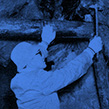Welding an Aroace, Hamamatsu Factory (2013)
The enduring passion of Yazaki’s employees
This section presents a look at episodes symbolizing the “Yazaki Spirit is Imagination,”
an attitude that remains unchanged since our predecessors built the company 75 years ago.
HOME The enduring passion of Yazaki’s employees Yazaki’s relief team contributes to recovery following the Isewan Typhoon

The Isewan Typhoon
Yazaki’s relief team contributes to recovery following the Isewan Typhoon

Arrival three days after the typhoon
In the evening of September 26, 1959, the Isewan Typhoon came ashore at Shionomisaki on the Kii Peninsula. The typhoon caused tremendous damage, particularly to the coastal areas of Mie and Aichi Prefectures.
Yazaki responded by sending a relief team to a client’s factory that was in need. The team arrived at its destination three days after the typhoon had passed. The factory, which was located in Nagoya’s Minato Ward, had been flooded to a depth of 1.5 meters, and it was doubtful whether many of its employees could come to work. In fact, only a few department and section heads were present at the factory. The situation was so dire, however, that no one had any idea where to start cleaning up. Just then, the relief team from Yazaki—the only company that had provided help—and its complement of twenty members showed up. Its two five-ton trucks and two light cars, all of which were stuffed with as much food and relief supplies as could be obtained, had to navigate extremely chaotic streets in order to reach the factory. The members of Yazaki’s relief team, who had brought the supplies and who now toiled in the mud with clenched teeth, earned words of deep appreciation and gratitude from all quarters.
Better a rice ball now than 100,000 yen in ten days
The then head of the Nagoya Branch Office remembers that time.
“‘Better to have one rice ball now than 100,000 yen in ten days.’ These were the words of our founder, Sadami Yazaki, as he gave the team a pep talk. He wanted us to get to the site as quickly as possible before anyone else. Sadami’s emphasis on initiative really demonstrated its value then. For their part, the members of the team did not undergo any special selection process or volunteer out of a competitive spirit. They simply wanted to help people to whom they were indebted in business, and who were now in difficult circumstances. I think the Yazaki attitude of valuing not only business relationships but also emotional ties was much appreciated by the client.”
Even after a half-century, we can be certain that this episode—in which Yazaki helped a client get back on its feet by making full use of the manpower provided by a total of 338 people and 54 vehicles—is still fresh in the minds of Yazaki employees of that time.
Note:
The Isewan Typhoon, which, as its name implies, struck the Ise Bay’s coastal region in Mie and Aichi Prefectures, caused the greatest amount of damage by a natural disaster in Japan since the Meiji Restoration. The typhoon killed 5,098 people, completely destroyed 36,135 buildings, partially destroyed 113,052 buildings, and washed away 4,703 homes. The number of people affected by the typhoon reached approximately 1.1 million, or 20% of the populations of Aichi and Mie Prefectures, where the damage was concentrated. Storm surges turned out to be a factor that magnified the damage. The sucking action caused by the low pressure and drifting seawater caused by fierce southerly winds as the typhoon moved north combined to raise the sea level by 3.89 meters, enough to spill over the tide embankments. A series of timber basins existed in Nagoya’s Minami Ward and Minato Ward, and groups of cut trees from them that measured one meter in diameter and ten meters in length crashed into industrial zones and residential areas of southwest Nagoya. It is reported that the majority of the 1,500 people who died in Minami Ward were killed by drifting timber.
EPISODE SELECTION















